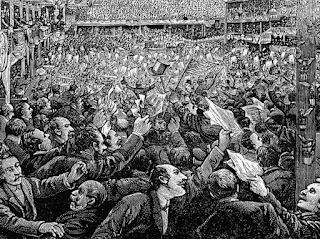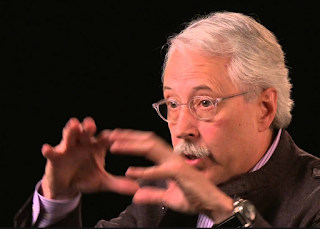Guest Blogger: William R.
Mansfield, Founder, Mansfield Institute for Public Policy and Social Change,
Inc.
In our postmodern world of rapid change and
complexity, there are no final authorities. Given the greater “wisdom of crowds,”
no single person can direct a complex business. A lone individual can only prod
it to think differently. The postmodern
leader is an activist.
The “Servant Leader”
Indeed, it could be argued that the terms activist and facilitator should replace leader
and manager as more descriptive of
the sort of “servant leadership” today’s world needs. Activists promote change with neither the
authority nor sufficient wisdom to decide matters for a crowd. Facilitators
coordinate the efforts of people to help them achieve goals without actually
controlling them.
Leaders and managers lived in a world of stable
structures with clear boundaries and fixed roles arranged in a neat pecking
order. Similarly, in the Middle Ages, the Earth was the center of the universe
and there was a definite up and down. Now there is no center, no absolute up or
down, or even solid objects. There are
just chaotic collections of particles, seemingly with minds of their own. A world in flux has few stable structures.
 |
| Change without plan or principles leads to chaos. |
Organizations driven by constant innovation
have also become unstable and loosely structured. They are fragmenting just as
surely as physical objects that try to move too fast. As a result, our efforts
to understand leadership must shift from the statics of structure to the
dynamics of rapid change. As in the physical world, leadership is no longer a
role in a stable structure but a brief impact that induces an organization to
think differently, even if only momentarily.
The main destabilizing force in business today
is the shifting balance of power. A hierarchy is a power structure. Those at
the top got there by claiming to know best where to take the organization and
how to get there.
If leadership provides direction, it must come
from a crowd where wisdom resides instead of flowing top-down as of old.
Crowd-sourced leadership is a discrete act not an ongoing, stable role. As a
type of action, groups — not just individuals — can show such leadership. It
can also originate from the frontlines or (albeit much less effectively) outside
the organization altogether.
Leaders as Activists
 |
| Gary Hamel, author of Leading the Revolution (2002). |
In Leading
the Revolution: How to Thrive in Turbulent Times (2002), Gary Hamel called
on all employees to become activists by advocating new products to top
management, such as did the Sony employee who convinced his bosses to develop
PlayStation. Hamel unfortunately did not
develop the connection between leading and being an activist other than to hint
at it in the title of his book.
Martin Luther King, Jr., Mahatma Gandhi, and Nelson
Mandela were activists. So are green
campaigners. When activists resort to
violence, as CESJ co-founder Father William J. Ferree, S.M., Ph.D., noted, we
rightly label them terrorists. When they
use constructive approaches to influence us, however, we classify them as
leaders.
Activists, by definition, must campaign for
their causes because they have no authority to make decisions for the groups
they seek to influence. If they succeed
in having a leadership impact, it might be a once-in-a-lifetime event. Activists might have no interest or
qualifications to be leaders in the positional sense.
If leadership is not a role within a group,
then it needn’t be limited to individuals. Thus activist groups like Green
Peace can have a leadership impact on other groups. It is often younger,
creative, rebellious types trying to make their mark who lead as activists.
The Act of Social Justice
 |
| Fr. William J. Ferree, S.M. |
To be effective, the true servant leader must sooner
or later (and better sooner rather than later) make the transition from
activist to facilitator. This means,
first of all, belonging to the group.
Simply joining or being a member of a group does not automatically mean
that one belongs to the group, although it is a necessary first step.
As Ferree pointed out, institutional change that
meets the demands of justice cannot be imposed from outside the group. Initiating change from outside the group is
the role of the activist. Actually
carrying out the change can only be done from within the group itself, once a
critical mass has been reached. This is
the principle of subsidiarity; effective agents of change must “subside” or
“subsist” within the group itself.
Subsidiarity in turn requires solidarity, that
is, not just being an “official” member of the group, but accepting and
internalizing the principles that define the group as that group, and no other. Neither
the leader nor any other member of the group can just be in the group. He or she must
truly belong to the group — and the group to him or her.
In other words, the servant leader, like
everyone else in the group, must learn to love the institution as he or she
loves himself. This is “social charity,”
the essential precondition to “social justice.”
 |
| Aristotle: Do good, avoid evil. |
That’s because just as individual charity
fulfills and completes individual justice, the justice directed to the individual good, social charity fulfills
and completes social justice, the justice directed to the common good. And the common
good is that vast institutional network within which people become more fully
human by becoming “virtuous,” that is, by building habits of doing good and
avoiding evil.
Thus, in order for people to build individual
habits of doing good (“virtue”), their institutions — their “social habits” —
must embody “structures of justice” that enable people to be virtuous most
effectively. This means that, if the
group’s institutions are not justly structured, people in the group must
organize to transform them from structures of injustice, to structures of
justice.
Personal Empowerment
The question then becomes how individuals within
a group gain the ability to carry out effective social change. It cannot be done by the command of the
leader or wishful thinking on the part of other group members. It can only be done by ensuring that each and
every member of the group is empowered, that is, has power: the ability for
doing.
And this leads to a serious problem in today’s
business environment. “Empowerment” in
most schools of management doesn’t mean having
power as a right, it means being given power as a gift.
 |
| "We are, like, so empowered . . . not." |
That’s because the definition of “empowerment”
in many of today’s business textbooks is “Allowing workers to make decisions up
to a predetermined dollar amount.” The
common example is restaurant or hotel workers who are permitted to “comp” upset
guests if the cost falls within a certain range. This helps convince guests that their
concerns are so important that they are taken care of immediately instead of
being referred up the chain of command.
Obviously that sort of thing isn’t true
empowerment. It’s just a company policy
to keep customers happy. If it turns out
it costs too much or doesn’t work, the policy can be changed and the workers
“dis-empowered.”
True empowerment means having power that cannot
be taken away, and in almost all cases that requires ownership of part of the
company — “Power,” as Daniel Webster said, “naturally and necessarily follows
property.”
The real power in a company is vested in the
owners, that is, the shareholders . . . or it should be. There are, frankly, serious problems these
days with the government and large owners denying minority owners their full
rights, including the right of control and the right to receive their fair
share of income — but that’s a discussion for another day.
Thus, if leaders truly want to empower workers
so that everyone can fulfill his or her obligation to care for the common good
of the company, he or she must organize with the workers to make everyone a
co-owner as fast and effectively as possible.
Otherwise, the leader may bear the title of facilitator, but he or she
is nothing but a dictator.
#30#

